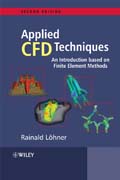
Applied computational fluid dynamics techniques: an introduction based on finite element methods
Löhner, Rainald
Essential reading for practitioners and graduates wishing to develop a complete knowledge of CFD techniques and fluid behavior, this new edition contains updated material as well as new chapters on Overlapping Grids, Embedded Grid Techniques, Free Surfaces, and Optimal Shape Design. The book also contains peusdo-codes, making it easier for readers to code the techniques enhancing the practical understanding of the topics and techniques involved. In addition to the traditional use of CFD techniques by the aerospace and automotive industry, new applications are coming up in various fields of engineering, medicine and physics. This book contains important new and updated material on overlapping and embedded grid methods, and a treatment of free surfaces and optimization, as well as new chapters on grid generation and optimal use of supercomputing hardware. INDICE: CONTENTS FOREWORD TO THE SECOND EDITION ACKNOWLEDGEMENTS 1 INTRODUCTION AND GENERAL CONSIDERATIONS 1.1 The CFD code 1.2 Porting research codes to an industrial context 1.3 Scope of the book 2 DATA STRUCTURES AND ALGORITHMS2.1 Representation of a grid 2.2 Derived data structures for static data 2.3 Derived data structures for dynamic data 2.4 Sorting and searching 2.5 Proximity ins pace 2.6 Nearest-neighbours and graphs 2.7 Distance to surface 3 GRID GENERATION 3.1 Description of the domain to be gridded 3.2 Variation of elementsize and shape 3.3 Element type 3.4 Automatic grid generation methods 3.5 Other grid generation methods 3.6 The advancing front technique 3.7 Delaunay triangulation 3.8 Grid improvement 3.9 Optimal space-filling tetrahedra 3.10 Gridswith uniform cores 3.11 Volume-to-surface meshing 3.12 NavierStokes gridding techniques 3.13 Filling space with points/arbitrary objects 3.14 Applications 4 APPROXIMATION THEORY 4.1 The basic problem 4.2 Choice of trial functions 4.3General properties of shape functions 4.4 Weighted residual methods with local functions 4.5 Accuracy and effort 4.6 Grid estimates 5 APPROXIMATION OF OPERATORS 5.1 Taxonomy of methods 5.2 The Poisson operator 5.3 Recovery of derivatives 6 DISCRETIZATION IN TIME 6.1 Explicit schemes 6.2 Implicit schemes 6.3 Awordof caution 7 SOLUTION OF LARGE SYSTEMS OF EQUATIONS 7.1 Direct solvers 7.2 Iterative solvers 7.3 Multigrid methods 8 SIMPLE EULER/NAVIERSTOKES SOLVERS 8.1 Galerkin approximation 8.2 LaxWendroff (TaylorGalerkin) 8.3 Solving for the consistent mass matrix 8.4 Artificial viscosities 8.5 Boundary conditions 8.6 Viscous fluxes 9 FLUX-CORRECTED TRANSPORT SCHEMES 9.1 The FCT Concept 9.2 Algorithmic implementation 9.3 Steepening 9.4 FCT for TaylorGalerkin schemes 9.5 Iterative limiting 9.6 Limiting for systems of equations 9.7 Examples 9.8 Summary 10 EDGE-BASED COMPRESSIBLE FLOWSOLVERS 10.1 The Laplacian operator 10.2 First derivatives: first form 10.3 First derivatives: second form 10.4 Edge-basedschemes for advection-dominated PDEs 11 INCOMPRESSIBLE FLOWSOLVERS 11.1 The advection operator 11.2 The divergence operator 11.3 Artificial compressibility11.4 Temporal discretization:projection schemes 11.5 Temporal discretization:implicit schemes 11.6 Temporal discretization of higher order 11.7 Acceleration to the steady state 11.8 Projective prediction of pressure increments 11.9 Examples 12 MESH MOVEMENT 12.1 The ALE frame of reference 12.2 Geometric conservation law 12.3 Mesh movement algorithms 12.4 Region of moving elements 12.5 PDE-based distance functions 12.6 Penalization of deformed elements 12.7 Special movement techniques for RANS grids 12.8 Rotating parts/domains 12.9 Applications 13 INTERPOLATION 13.1 Basic interpolation algorithm 13.2 Fastest 1-timealgorithm:brute force 13.3 Fastest N-time algorithm: octree search 13.4 Fastestknown vicinity algorithm: neighbour-to-neighbour 13.5 Fastest grid-to-grid algorithm: advancing-front vicinity 13.6 Conservative interpolation 13.7 Surface-grid-to-surface-grid interpolation 13.8 Particlegrid interpolation 14 ADAPTIVE MESH REFINEMENT 14.1 Optimal-mesh criteria 14.2 Error indicators/estimators 14.3 Refinement strategies 14.4 Tutorial: h-refinement with tetrahedra 14.5 Examples 15 EFFICIENT USE OF COMPUTER HARDWARE 15.1 Reduction of cache-misses 15.2 Vector machines 15.3 Parallel machines: general considerations 15.4 Shared-memory parallel machines 15.5 SIMD machines 15.6 MIMD machines 15.7 The effectof Moores law on parallel computing 16 SPACE-MARCHING AND DEACTIVATION 16.1 Space-marching 16.2 Deactivation 17 OVERLAPPING GRIDS 17.1 Interpolation criteria 17.2 External boundaries and domains 17.3 Interpolation: initialization 17.4 Treatment of domains that are partially outside 17.5 Removal of inactive regions 17.6 Incremental interpolation 17.7 Changes to the flow solver 17.8 Examples 18 EMBEDDED AND IMMERSED GRID TECHNIQUES 18.1 Kinetic treatment of embedded or immersed objects 18.2 Kinematic treatment of embedded surfaces 18.3 Deactivation of interior regions 18.4 Extrapolation of the solution 18.5 Adaptive mesh refinement 18.6 Load/flux transfer 18.7 Treatment of gaps or cracks 18.8 Direct link to particles 18.9 Examples 19 TREATMENT OF FREE SURFACES 19.1 Interface fitting methods 19.2 Interface capturing methods 20 OPTIMAL SHAPE AND PROCESS DESIGN 20.1 The general optimization problem 20.2 Optimization techniques20.3 Adjoint solvers 20.4 Geometric constraints 20.5 Approximate gradients 20.6 Multipoint optimization 20.7 Representation of surface changes 20.8 Hierarchical design procedures 20.9 Topological optimization via porosities 20.10 Examples References
- ISBN: 978-0-470-51907-3
- Editorial: John Wiley & Sons
- Encuadernacion: Cartoné
- Páginas: 524
- Fecha Publicación: 29/02/2008
- Nº Volúmenes: 1
- Idioma: Inglés
